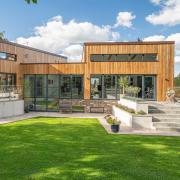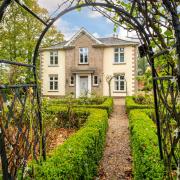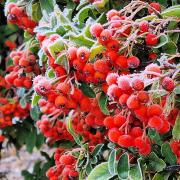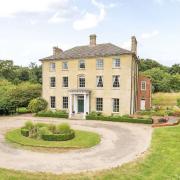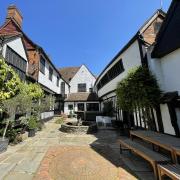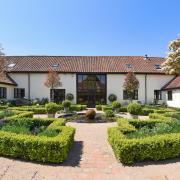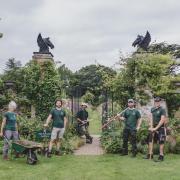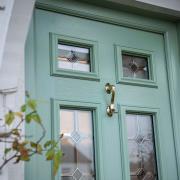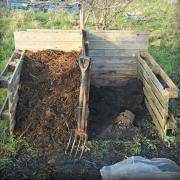Who could resist a visit to a garden with the address Wolfe Hall? So, the other one that gives its name to Hilary Mantel's best selling Tudor trilogy is a few counties away and spelt differently, but why let that spoil this romance?
I arrive at Mark and Jo Howard's beautiful property at Barrow, about eight miles west of Bury St Edmunds, on a cool, damp day at the end of May. They're just six weeks away from opening their five-acre garden to visitors, in support of the National Garden Scheme, for the very first time.
They seem remarkably relaxed for two people who've not done much gardening before, let alone inviting people in to see what they've achieved in the short time they've lived at Wolfe Hall.

But, as Jo says, this is not a show garden. 'It's an ordinary garden created by ordinary people. I mean, we don't know what we're doing,' she jokes. She's being modest, of course. It may be only three years in the making, but the garden is already beautiful and, given a few more years, will be spectacularly wonderful, as a guided tour will reveal.
Mark and Jo have lived at Wolfe Hall for six years, having moved from Worlington, a few miles away. Mark is from Warrington originally; Jo is a Suffolk girl, brought up on the Euston estate where her father was farm manager.
'We loved the house when we saw it,' says Mark. 'We wanted a place to live that had plenty of outdoor space that would give us things to do.' Mark, an engineer, had sold his business; Jo has a background in catering. They were both ready for the challenge of taming Wolfe Hall's five and a half acres, which had primarily been used as paddocks for horses.

The property wasn't always called Wolfe Hall but was originally known as Mundefords, most likely after Osbert de Mundeford, of Mundford in Norfolk, acquired land in Barrow. The house dates from 1540 but Mark's research has found that it isn't the original dwelling. It probably replaced an older house built on another part of the site which proved too wet. There's still a moat today.
The house contains some remnants of Bury St Edmunds abbey, stone that was sold off when the abbey was dissolved in 1539, and timber from a variety of sources. It has some impressive beams and panels, usually a sign of wealth since wood was an expensive building material.
In more recent times, Wolfe Hall was owned by a local farming family, and for a period in the 1970s it was rented to an order of nuns, who built a bungalow on the site and used it as an ecclesiastical retreat. This is certainly a very peaceful part of west Suffolk's rolling countryside.

For Mark and Jo, creating a garden out of an equestrian property was a considerable challenge, especially as Mark was still working for the first two years, but it's one they've relished. Before they could even contemplate planting, their first tasks were to remove a lot of fences, and restore the heavy clay soil, compacted by the tread of horses, into something workable.
Books, YouTube and fellow gardeners have all expanded their knowledge, plus Jo treated Mark to a composting course run by author and gardener Charles Dowding, the king of 'no dig' gardening. Mark has established an impressive vegetable garden, which takes many hours of hard work, but enables the couple to be largely self-sufficient.
They've planted more than 250 trees, 600 metres of hedging and countless shrubs, perennials and spring bulbs, not working to any particular plan, but taking inspiration from the great Piet Oudolf, the Dutch garden designer, whose designs and plant compositions use bold drifts of herbaceous perennials and grasses, to provide structure, colour and texture.

'We actually contacted him and asked him if he'd do a design for us,' says Mark. 'He couldn't, of course, but he did give us his list of favourite plants for clay soil.' So, using that as a guide they chose RHS award of merit varieties, sourcing many of them from Chris Watson, of Watsons Plants in nearby Depden.
They've established a new woodland area, a new orchard – in addition to the very old, gnarly but still productive orchard – stunning herbaceous borders, lawns framed with topiary, an avenue of young apple trees.
Circles and arcs are a bit of a theme, which keeps the garden flowing gently from one area to the next, and near the entrance to the property, moving gracefully in the wind, stands a kinetic sculpture by Will Carr. Based on a sine wave, it was commissioned by Mark, partly as a reference to his engineering background.

Another stunning sculpture, a statuesque torso in smooth Indian granite by Paul Vanstone, occupies a central position in the garden, against a backdrop of a beautiful oak tree. Wherever you are in this garden there's something to look at, something to delight.
We make our way to a fabulous raised area at the end of the garden which looks out over the surrounding countryside. In the distance, under a big west Suffolk sky, dark forest marks the bounds of Ickworth estate. It's pretty special.
I'm in awe of what Mark and Jo have achieved; the two of them have worked tirelessly through some difficult conditions. Keeping young trees and plants alive during the long, hot summer of 2022 couldn't have been easy. Not everything has been a success, but that's gardening; trial and error.

'It's never finished,' says Mark. He still has a smile on his face, though, and they're both looking forward to their first NGS event after opening for St Nicholas Hospice last year. The garden should be at its best in mid-July... don't miss it.
Wolfe Hall, Barrow, Bury St Edmunds, IP29 5EZ
ngs.org.uk/gardens/wolfe-hall-ip29




